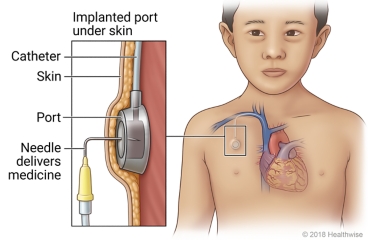Overview

An implanted port is a device placed in a vein so that medicine, blood, nutrients, or fluids can be put directly into your child's blood. The port may also be used to draw blood for tests. People can have a port for weeks or months.
Your child will get medicine to make them sleep before the port is put in.
The port is placed, in most cases, under the skin of your child's chest below the collarbone. The port is about the size of a quarter, but thicker. A thin, flexible tube runs under the skin from the port into a large vein.
Some ports have a small reservoir that can be filled with medicine or fluid. The medicine slowly flows from the reservoir into your child's blood. A special needle (Huber needle) may be placed in the port for a short time while your child is getting medicines or fluids.
Your child's port will need regular flushing to keep it open. Your child's care team will do this for you.
Follow-up care is a key part of your child's treatment and safety. Be sure to make and go to all appointments, and call your doctor if your child is having problems. It's also a good idea to know your child's test results and keep a list of the medicines your child takes.
How can you care for your child at home?
- After the port is inserted, have your child take it easy for about 1 day. Your child will be able to return to normal activities shortly after. How soon depends on how your child feels, what types of activities your child does, and why the port is needed.
- Talk to the doctor about any limits on your child's activity. Your child probably will be able to bathe and swim.
- You may cover the area with a gauze bandage if it rubs against clothing. Change the bandage every day.
- Don't let your child wear clothing (like a sports bra, suspenders, or a backpack strap) that rubs the skin over the port.
- Have your child be careful when pulling a seat belt across the chest. It's okay if the seat belt lies over the port.
- Consider having your child wear a medical alert bracelet and carry a medical alert card. These will tell health care providers about the port in case your child needs emergency care.
- Make sure to go to all follow-up appointments. Your child's port will need to be flushed out regularly to keep it open. Your child's care team will do this for you.
When should you call for help?
Call 911 anytime you think your child may need emergency care. For example, call if:
- Your child has trouble breathing.
Contact your doctor now or seek immediate medical care if:
- Your child has pain or swelling in the neck or the arm near the port.
- Your child has symptoms of infection, such as:
- Increased pain, swelling, warmth, or redness.
- Red streaks leading from the area.
- Pus or blood draining from the area.
- A fever.
Watch closely for any changes in your child's health, and be sure to contact your doctor if there are any problems with your child's port.
Where can you learn more?
Go to http://www.healthwise.net/patientEd
Enter I175 in the search box to learn more about "Implanted Port in Children: Care Instructions".
Current as of: October 1, 2025
Author: Ignite Healthwise, LLC Staff
Clinical Review Board
All Ignite Healthwise, LLC education is reviewed by a team that includes physicians, nurses, advanced practitioners, registered dieticians, and other healthcare professionals.

